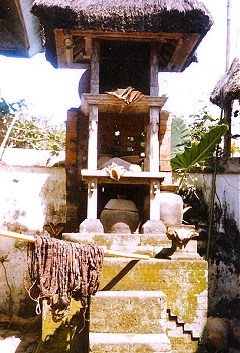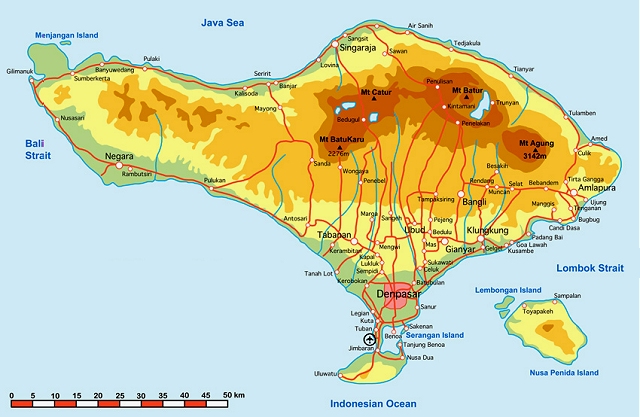Ikat textiles on Bali - for ceremonial use onlyThe Balinese ikat textiles differ from those in eastern Nusa Tenggara both in technique and usage. Instead of the warp ikat common on most of the other islands, the Balinese work in weft ikat, called endek, or in double ikat. And their cloths are not made for daily attire, but for ceremonial use only. Many Balinese ikats, such as the renowned kamben cepuk - made either on Bali itself or on the off-shore island Nusa Penida - are never worn at all, just displayed during ceremonies. In fact many a cepuk is never displayed in its full glory, but carried among the offerings folded up into a small package. Opening it up is not even necessary: the neighbours will be able to judge the quality of the weaving from a distance.Another precious type of ceremonial textile is made in the small east coast village of Tenganan Pegeringsingan, home of the famous geringsing double ikat. Both geringsing and cepuk are regarded by the Balinese as objects with magical powers, and are still used in a variety of rituals. There are several less known kinds of ceremonial ikat textiles produced on Bali, mostly in silk. Among them are the extremely rare sacred bebali, found in a few very well endowed and excellently managed collections such as the one of the National Gallery of Australia, and the more easily found kamben with scenes from the Ramayana and other figurative and floral motifs. In western eyes these can look a little garish, and perhaps for that reason are not as avidly sought by overseas collectors as the more austere geringsing and kamben cepuk.
Hindu heritage still shapes traditionBali, 'The Island of the Gods' is the only island in Indonesia where the majority religion is Hinduism - though Islam, and Christianity to a lesser extent, are encroaching, the former as a result of government sponsored immigration from other Indonesian islands, particularly from overpopulated Java; the latter as a result of missionary activity.Hinduism came to Bali in the 15th C. as the Hindu empire of the Majapahit crumbled under the invasion of Islam, and a number of royal families with their dependents crossed the narrow sea strait that separates East Java from Bali, settled here and took over, stamping the island with their Hindu culture. They did this so effectively that they have managed to withstand - so far - both colonial pressures to convert to Christianity and a newly assertive Islam. The Balinese were helped by the island's natural bounty. The land is so fertile and the rain so plentiful that the islanders can harvest rice twice a year. So, Bali has always been a rich place, and it shows. The people spend much of their time preparing for ceremonies, holding ceremonies and recovering for ceremonies, all of which require splendorous and elaborate offerings that display a joyful creativity, and highly developed artisanal skills across the whole gamut of the arts. These consummate skills are also in evidence in Balinese textile manufacture. Apart from Gujarat in India and Oshima in Japan, Bali is the only place in the world where the technically very demanding double ikat is produced - albeit not by Hindus, but by Bali Aga, said to be descendants of the original inhabitants of the island before the Hindu invasion. As mentioned in the introduction, nearly everywhere in Indonesia ancestors are venerated, spirits feared and placated, forces of nature respected with religious fervour. Bali is no exception. In fact its dominant religion, Hinduism, has developed in a spiritual environment very similar to that which was prevalent here in prehistoric times. Hinduism, also in its original form as practiced in India, is an extremely heterodox religion, allowing endless variation and personal interpretation, and it incorporates various pre-Vedic belief systems, such as nature worship, belief in the power of inanimate objects such as remarkably shaped rocks, waringin trees, et cetera. So unlike Islam and Christianity which would consider such beliefs a form of idolatry or pagan nonsense, Hinduism considers it perfectly orthodox to ascribe certain cloths, like those made in Tenganan Pegeringsingan, supernatural powers, e.g. the power to heal the sick or bring blessings to certain transitional life phases or demanding endeavours. | ||||||



